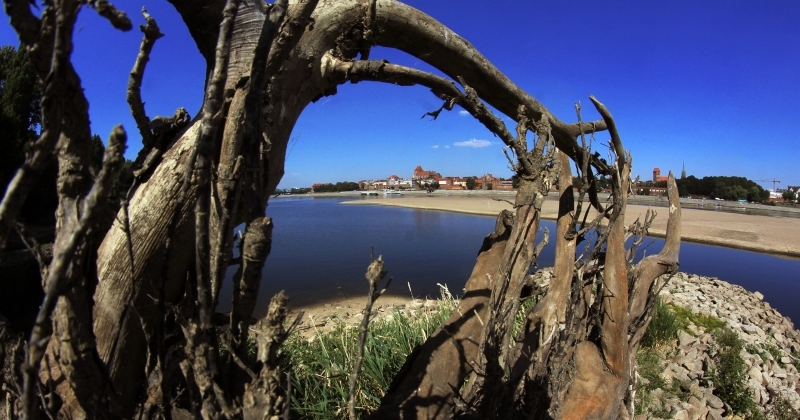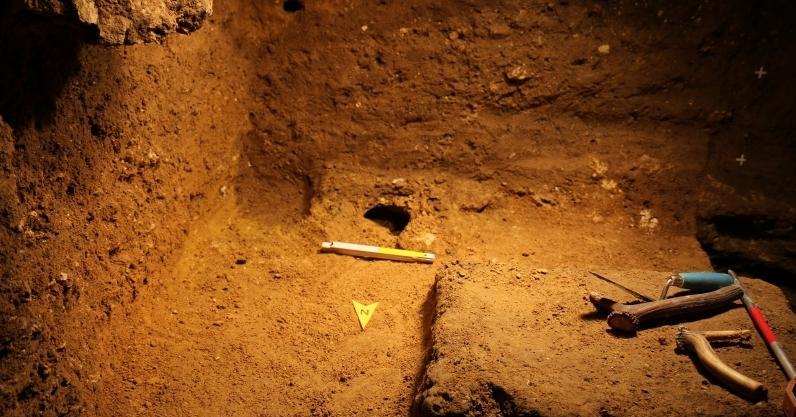 Natural sciences
Natural sciences
Chronicles and trees spoke of droughts in Poland
Researchers from the Nicolaus Copernicus University found a connection between drought and low growth of annual rings in trees. They compared dendrochronological data with chronicle records and rainfall measurements and described droughts occurring in Poland from its early days until 2015.
Historians found records of over 100 droughts in Poland in the years 1451-1800, including 17 so-called mega droughts. Researchers compared them with dendrochronological data. “Actually, we had data from the end of the 10th century until 2015," says Prof. dr habil. Rajmund Przybylak from the NCU Faculty of Earth Sciences and Spatial Management, who also represents the University's Climate Change Research Centre established in December 2019. “However, over the last 200 years we have already had accurate measurements of precipitation. The biggest problem is with the documentation from the first half of the 17th century, because due to the turbulent history of our country, mainly during the so-called Swedish deluge, most of the data was lost, destroyed or displaced."
Researchers stress that in this type of work it is best to combine data from several sources. The most reliable are the instrumental data. “We are in a good situation, because in Poland we have over 200 years of continuous measurements of precipitation from some stations (Wroclaw, Krakow, Warsaw), and we have a series for Gdansk since 1739 (but with a break from 1786-1850), so we also took advantage of it," explains Professor Przybylak – “We compared these measurements with indirect data, i.e. historical and dendrochronological. If we have instrumental data, we can calibrate indirect data, establish a statistical relationship. If this works, with the help of this relationship we recreate the climate that prevailed before, i.e. before the instrumental measurements."
This was an additional indicator that was examined. It coincided with the droughts found on the basis of historical data and rainfall measurements," assures the climatologist.
It sounds complicated, but it is impossible to examine past droughts in any other way, because the oldest records showing the amount of precipitation measured with rain gauges date back to the end of the first half of the 18th century, and the indirect data themselves are often burdened with a margin of error. In addition to rainfall, the annual growth of the tree rings is influenced by temperature and other non-climatic factors. As Professor Przybylak explains, the temperature in the Polish lowland has the most significant impact on the growth of trees at the turn of winter and spring. It is only in the warm half-year, starting in May, that precipitation starts to play the biggest role. It is so in the lowlands, because in the mountains, where it is colder due to the altitude, the annual growth of trees is mainly influenced by the summer temperature. “This was an additional indicator that was examined. It coincided with the droughts found on the basis of historical data and rainfall measurements," assures the climatologist.
Just as dendrochronological data cannot be used alone, the works on the past climate cannot be based solely on chronicles. The historical sources are not always accurate either. Historians have their own methods to distinguish between those of the first hand and those of the second or third. So it is better to have several research methods, and if two or three of them indicate a drought in a given year, we are more certain that this drought actually occurred in that year.
Researchers identified most droughts in the Pomerania and Silesia as they had the most data from those regions. They admit that sometimes it is necessary to generalize and assume that if we had a drought in two distant regions, such as the Pomerania and Silesia, it is highly probable that droughts may have occurred throughout Poland. Researchers emphasize that they dealt with Poland within its contemporary borders, because the historical ones had changed very often over the centuries.
Research has shown that in Poland we had clearly more droughts in the second half of the seventeenth and eighteenth centuries than in other periods, e.g. in the previous sixteenth and late fifteenth centuries. In the years 1722-2015 these were mainly winter droughts, while historical documents from the period 1451-1800 rarely mention droughts at that time of the year. “This is the outcome of the analysis of the standardized precipitation index calculated for the eight-year precipitation series from Poland," explains Professor Przybylak. “Previously, chroniclers, just like today's journalists, most often described extreme situations, nobody noticed what was close to normal. The chroniclers sometimes wrote that there was little snow in a given year, but they mainly focused on the summer, that it was dry and not much had grown."
They paid more attention to the economic and social aspects rather than the climate itself. Since snow, apart from its use in transport, was of little importance, most people were not troubled by it.
However, there were also such accounts as those by Voivode Jan Antoni Chrapowicki, who in the second half of the 17th century conducted daily observations of the weather for a period of 30 years and recorded them in his diary, or by Gottfried Reyger, who asa a 17-year-old boy in 1721 began to record his observations in Gdańsk and kept the accounts until his death in 1786," - says Professor Przybylak, - “The work we do on creating a weather database of the past centuries will never be finished, because there are countless sources in the archives, and they are usually not catalogued. There are documents from the fifteenth, sixteenth and seventeenth centuries, there is everything, So, you may be just lucky to find something."
The climatologist stresses that the amount of snow is very important in nature, and its scarce precipitation aggravates spring and summer droughts. The water from the rainfall evaporates quickly, because winter is warm and in spring there is not as much water as when the snow lies on the fields until March or April and slowly melts away. This was the case this year. In fact, in winter the rain fell more than average, but there was no snow at all. “When there is no moisture in the soil, we do not even have to have too high temperatures for the soil to dry out quickly," says Prof. Przybylak – “Few people pay attention to that. In the studies of droughts, the winter period is often omitted, and analyses start from the vegetation period, from spring, because it is significant."
Today, with the current warming, droughts are increasingly caused by rising temperatures. Precipitation is at the same level or even slightly higher, but drought can be greater. Due to a much greater temperature rise, evaporation is greater, and the water balance is negative. If researchers were to consider temperature and the evaporation caused by it in their research, the number of droughts recorded in recent years would increase slightly. However, in previous centuries, when the temperature was fairly stable, it was primarily precipitation that had to be examined, and that was also what the researchers at the Nicolaus Copernicus University did.
The reason for droughts and floods, apart from the aforementioned rising temperature, is and will be in the future not that the precipitation is the same, or only slightly higher, but that its distribution and intensity changes," explains Prof. Przybylak.
At present, with a significant increase in temperature, precipitation must be much higher to compensate for evaporation. Globally, precipitation is slightly increasing, in Poland there are no such trends yet, although greater precipitation is forecasted for the coming years, but mainly in winter. As it was this year. “The reason for droughts and floods, apart from the aforementioned rising temperature, is and will be in the future not that the precipitation is the same, or only slightly higher, but that its distribution and intensity changes," explains Prof. Przybylak. – “Today, tomorrow, for a week it is raining heavily, and then nothing for a long, long time. It is raining hard again, and then nothing for a long time, long time. Then most of the water flows into rivers and then into the sea, earlier causing frequent floods. Water does not infiltrate deep into the ground, does not increase soil moisture and does not supply groundwater, and these long intervals between precipitation episodes are unfavourable and result in droughts. This is what we can now observe on a global scale."
The climatologist, however, reminds that it hasn't rained in Toruń since March 15. Nevertheless, this April was still better in this respect than last year's when it rained 0.8 mm, but it was very warm, from 5th April last year, summer basically started. This year's April, on the other hand, was much cooler, so evaporation was smaller, which protects us from even faster drought intensification.
It hasn't rained much in our town for two years. For Toruń the mean annual sum of precipitation is 530 mm, and last year it fell down to 450 mm (the average sum of two measurement points). In 2018 it was even less - 411.2 mm. However, about 600 mm evaporates annually, so we still have a water shortage. “These are not the lowest rainfall sums in history," notes Professor Przybylak. – “I noted that since 1951 we have never had less than 300 mm of precipitation, but the years were really dry. In 1989, there was 310.4 mm of rainfall, in 1951. - 312.2 mm, and in 1982. - 316.1 mm. These are the three years when we had the least rainfall. When it falls less in one year and harder in the following years, it is not so bad. It's worse when dry years start to follow one another."
In Toruń, rainfall usually reaches 30 mm. Last year it was 0.8 mm, and it is less this year. Climatologists hope that May will be more favorable for plants. The average for May is about 50 mm, and last year there was nearly 80 mm of rain, so this partially compensated the April losses. Unfortunately, the following months, in the summer, were dry again . Yet, there was more rain in September.
Lately, the summers have been generally dry and hot, because our air circulation has been changing - explains Prof. Przybylak. - In the summer there is almost no circulation of western air at all, we have a midday exchange. There is a lot of sun, heat, few clouds and rain. Once it usually rained in July, it was best to take a holiday leave in August. Now it's no longer true. During holidays everyone gets equal chances for good weather."
Together with Prof. Przybylak, the subject of droughts in Poland was examined by: dr habil. Piotr Oliński, NCU Prof., dr Radosław Puchałka from the Faculty of Biological and Veterinary Sciences, dr Aleksandra Pospieszyńska from the Faculty of Earth Sciences and Spatial Management, dr Henryk Paweł Dąbrowski, Director of the Archaeological Museum in Biskupin and dr Janusz Filipiak from the Faculty of Oceanography and Geography of the University of Gdańsk. Theresearchers' article Droughts in the area of Poland in recent centuries in the light of multi-proxy datawas published at the beginning of April in the journal "Climate of the Past" dedicated to works on the reconstruction of past climates.
 NCU News
NCU News






 Humanities and arts
Humanities and arts
 Humanities and arts
Humanities and arts